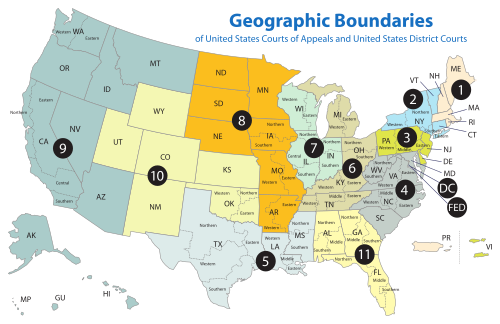United States District Court for the Eastern District of Tennessee
| United States District Court for the Eastern District of Tennessee | |
|---|---|
 | |
| Established | April 29, 1802 |
The United States District Court for the Eastern District of Tennessee (in case citations, E.D. Tenn.) is the federal court in the Sixth Circuit whose jurisdiction covers all of East Tennessee and a portion of Middle Tennessee. The court has jurisdiction over 41 counties with 4 divisions. Based in Knoxville, Tennessee, it maintains branch facilities in Chattanooga, Tennessee; Greeneville, Tennessee; and Winchester, Tennessee.
- The Southern Division, based in Chattanooga, Tennessee, serves Bledsoe, Bradley, Hamilton, Marion, McMinn, Meigs, Polk, Rhea and Sequatchie counties.
- The Northeastern Division, based in Greeneville, Tennessee, serves Carter, Cocke, Greene, Hamblen, Hancock, Hawkins, Johnson, Sullivan, Unicoi and Washington counties.
- The Northern Division, based in Knoxville, Tennessee, serves Anderson, Blount, Campbell, Claiborne, Grainger, Jefferson, Knox, Loudon, Monroe, Morgan, Roane, Scott, Sevier and Union counties.
- The Winchester Division serves Bedford, Coffee, Franklin, Grundy, Lincoln, Moore, Warren and Van Buren counties.
The United States Attorney for the Eastern District of Tennessee represents the United States in civil and criminal litigation in the court. The current US Attorney is William C. Killian.[1]
The court was established by the Judiciary Act of 1801 ("Midnight Judges" Act) wherein Congress created a new Sixth Circuit with two districts in Tennessee. Since 1797, the state had been organized by Congress into one judicial district with one judge, John McNairy.
Tennessee – along with Kentucky, Ohio, and Michigan – is located within the area covered by United States Court of Appeals for the Sixth Circuit, and appeals are taken to that court (except for patent claims and claims against the U.S. government under the Tucker Act, which are appealed to the Federal Circuit).
History
The United States District Court for the District of Tennessee was established with one judgeship on January 31, 1797, by 1 Stat. 496.[2][3] The judgeship was filled by President George Washington's appointment of John McNairy. Since Congress failed to assign the district to a circuit, the court had the jurisdiction of both a district court and a circuit court. Appeals from this one district court went directly to the United States Supreme Court.
On February 13, 1801, in the famous " Midnight Judges" Act of 1801, 2 Stat. 89, Congress abolished the U.S. district court in Tennessee,[3] and expanded the number of circuits to six, provided for independent circuit court judgeships, and abolished the necessity of Supreme Court Justices riding the circuits. It was this legislation which created the grandfather of the present Sixth Circuit. The act provided for a "Sixth Circuit" comprising two districts in the State of Tennessee, one district in the State of Kentucky and one district, called the Ohio District, composed of the Ohio and Indiana territories (the latter including the present State of Michigan). The new Sixth Circuit Court was to be held at "Bairdstown" in the District of Kentucky, at Knoxville in the District of East Tennessee, at Nashville in the District of West Tennessee, and at Cincinnati in the District of Ohio. Unlike the other circuits which were provided with three circuit judges, the Sixth Circuit was to have only one circuit judge with district judges from Kentucky and Tennessee comprising the rest of the court. Any two judges constituted a quorum. New circuit judgeships were to be created as district judgeships in Kentucky and Tennessee became vacant.[4]
The repeal of this Act restored the District on March 8, 1802, 2 Stat. 132.[3] The District was divided into the Eastern and Western Districts on April 29, 1802.[2] On February 24, 1807, Congress again abolished the two districts and created the United States Circuit for the District of Tennessee. On March 3, 1837, Congress assigned the judicial district of Tennessee to the Eighth Circuit. On June 18, 1839, by 5 Stat. 313, Congress divided Tennessee into three districts, Eastern, Middle, and Western.[2][3][5] Again, only one judgeship was allotted for all three districts. On July 15, 1862, Congress reassigned appellate jurisdiction to the Sixth Circuit. Finally, on June 14, 1878, Congress authorized a separate judgeship for the Western District of Tennessee, at which time President Rutherford B. Hayes appointed David M. Key as judge for the Eastern and Middle Districts of Tennessee. The first judge to serve only the Eastern District of Tennessee was Robert Love Taylor, appointed by Harry S. Truman.
Current composition of the Court
| # | Title | Judge | Duty station | Born | Term of service | Appointed by | ||
|---|---|---|---|---|---|---|---|---|
| Active | Chief | Senior | ||||||
| 21 | Chief Judge | Thomas A. Varlan | Knoxville | 1956 | 2003–present | 2012–present | — | G.W. Bush |
| 22 | District Judge | J. Ronnie Greer | Greeneville | 1952 | 2003–present | — | — | G.W. Bush |
| 23 | District Judge | Harry Sandlin Mattice Jr. | Chattanooga | 1952 | 2005–present | — | — | G.W. Bush |
| 24 | District Judge | Pamela L. Reeves | Knoxville | 1954 | 2014–present | — | — | Obama |
| 25 | District Judge | Travis Randall McDonough | Chattanooga | 1972 | 2015–present | — | — | Obama |
| 18 | Senior Judge | Robert Leon Jordan | Knoxville | 1934 | 1988–2001 | — | 2001–present | Reagan |
| 19 | Senior Judge | Curtis Lynn Collier | Chattanooga | 1949 | 1995–2014 | 2005–2012 | 2014–present | Clinton |
| 20 | Senior Judge | Thomas W. Phillips | Knoxville | 1943 | 2002–2013 | — | 2013–present | G.W. Bush |
Former judges
| # | Judge | State | Born–died | Active service | Chief Judge | Senior status | Appointed by | Reason for termination |
|---|---|---|---|---|---|---|---|---|
| 1 | John McNairy | TN | 1762–1837 | 1802–1833 | — | — | Washington | resignation |
| 2 | Morgan Welles Brown | TN | 1800–1853 | 1834–1853 | — | — | Jackson | death |
| 3 | West Hughes Humphreys | TN | 1806–1882 | 1853–1862 | — | — | Pierce | removal |
| 4 | Connally Findlay Trigg | TN | 1810–1880 | 1862–1880 | — | — | Lincoln | death |
| 5 | David M. Key | TN | 1824–1900 | 1880–1895 | — | — | Hayes | retirement |
| 6 | Charles Dickens Clark | TN | 1847–1908 | 1895–1908 | — | — | Cleveland | death |
| 7 | Edward Terry Sanford | TN | 1865–1930 | 1908–1923 | — | — | T. Roosevelt | reappointment |
| 8 | Xenophon Hicks | TN | 1872–1952 | 1923–1928 | — | — | Harding | reappointment |
| 9 | George Caldwell Taylor | TN | 1885–1952 | 1928–1949 | 1948–1949 | 1949–1952 | Coolidge | death |
| 10 | Leslie Rogers Darr | TN | 1886–1967 | 1939–1961 | 1949–1961 | 1961–1967 | F. Roosevelt | death |
| 11 | Robert Love Taylor | TN | 1899–1987 | 1949–1984[6] | 1961–1969 | 1984–1987 | Truman | death |
| 12 | Frank Wiley Wilson | TN | 1917–1982 | 1961–1982 | 1969–1982 | — | Kennedy | death |
| 13 | Charles Gelbert Neese | TN | 1916–1989 | 1961–1982[7] | — | 1982–1989 | Kennedy | death |
| 14 | Herbert Theodore Milburn | TN | 1931–2016 | 1983–1984 | 1984–1984 | — | Reagan | reappointment |
| 15 | Thomas Gray Hull | TN | 1926–2008 | 1983–2002 | 1984–1991 | 2002–2008 | Reagan | death |
| 16 | James Howard Jarvis II | TN | 1937–2007 | 1984–2002 | 1991–1998 | 2002–2007 | Reagan | death |
| 17 | Robert Allan Edgar | TN | 1940–present | 1985–2005 | 1998–2005 | 2005–2016 | Reagan | retirement |
Succession of seats
|
|
|
|
| ||||||||||||||||||||||||||||||||||||||||||||||||||||||||||||||||||||||||||||||||||||||||||||||
|
| ||||||||||||
See also
Notes
- ^ "Office of the United States Attorneys". Executive Office for United States Attorneys. United States Department of Justice. Retrieved 25 January 2014.
- ^ a b c Asbury Dickens, A Synoptical Index to the Laws and Treaties of the United States of America (1852), p. 391.
- ^ a b c d U.S. District Courts of Tennessee, Legislative history, Federal Judicial Center.
- ^ The Honorable Harry Phillips, "History of the Sixth Circuit".
- ^ Alfred Conkling, A Treatise on the Organization, Jurisdiction and Practice of the Courts of the United States (1842), p. 42.
- ^ Recess appointment; formally nominated on January 5, 1950, confirmed by the United States Senate on March 8, 1950, and received commission on March 9, 1950.
- ^ Recess appointment; formally nominated on January 15, 1962, confirmed by the United States Senate on February 7, 1962, and received commission on February 17, 1962.
External links

